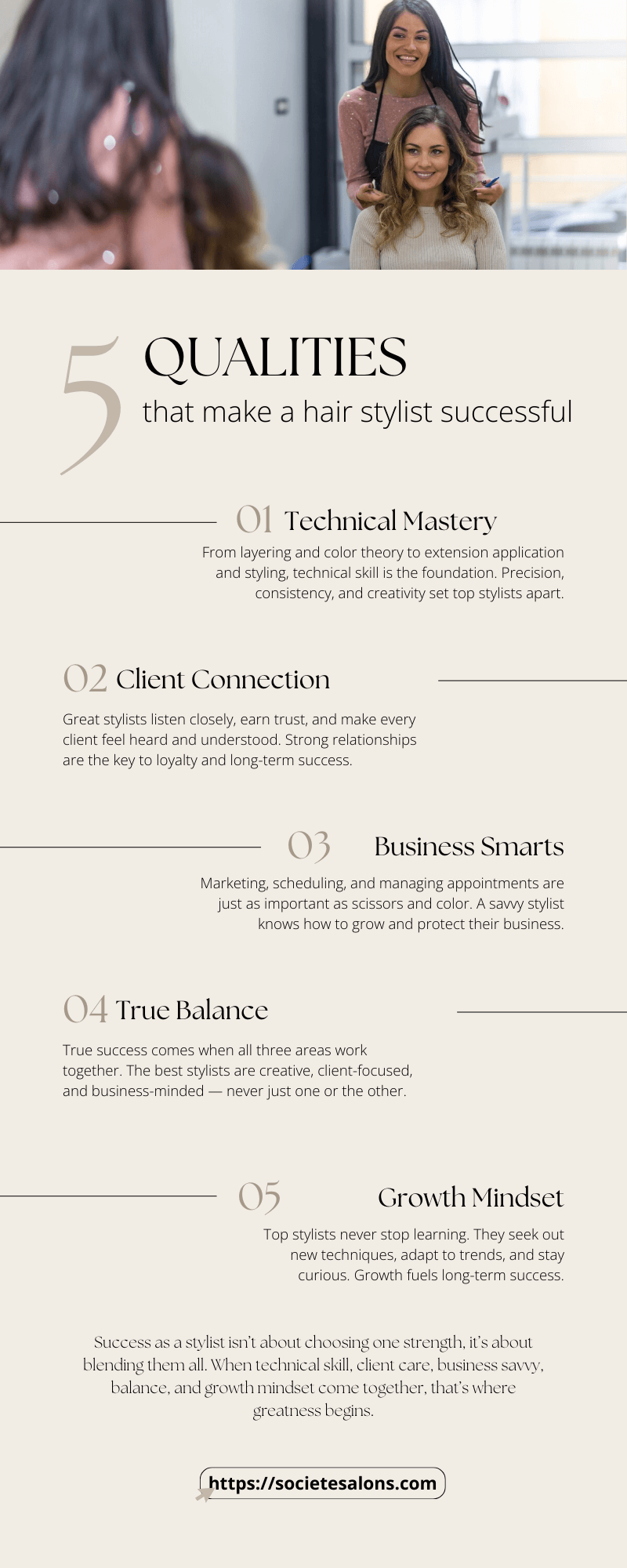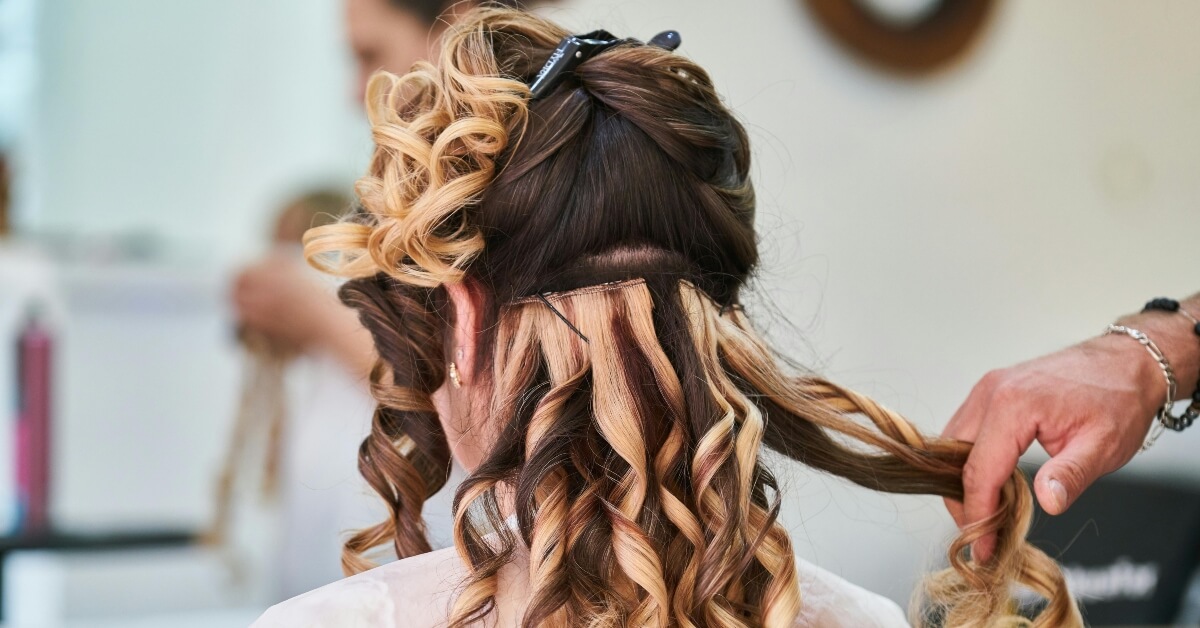Do you consider yourself to be a premier hair stylist? Do you think you still have work to do to consider yourself to be at this level?
Check out Societe Salon’s comprehensive list of 23 hair stylist qualities that make a stylist great, elite, premier or whatever other adjective you would like to use. The point is that these characteristics allow hairdressers to continually create exceptional hair for their clients.
Clients can also review this list if they are looking for a great hair stylist near them. Spotting these characteristics can be a strong indicator of the quality of work a hairdresser does.
Societe Salon has a tireless commitment to delivering exceptional hair to all our clients. If you are looking to join award-winning master stylist Kathleen Van Vorst and the exceptional team at Societe Salon, schedule a meeting today. We provide the training and guidance our stylists need to shine. We show off our stylists to enhance their credibility. Join us so you can work with and learn from the best. Schedule an appointment with the salon manager.
10 Key Points From This Blog
- Elite stylists combine technical skill with personality — Qualities like friendliness, empathy, creativity, and professionalism matter just as much as haircutting ability.
- Communication and listening are crucial — Understanding client needs and managing expectations through clear, honest communication is key to building trust and satisfaction.
- Consistency and productivity set great stylists apart — Delivering high-quality results every day, not just occasionally, is what builds a loyal client base.
- Appearance and punctuality matter — Looking polished and showing up on time signals professionalism and earns respect from both clients and coworkers.
- Education never stops — Great stylists pursue ongoing learning through courses, workshops, and mentorship to stay ahead of trends and perfect their craft.
- Stylists are part therapist, part artist — Compassion and emotional intelligence help stylists connect with clients beyond the chair, making each visit more meaningful.
- Teamwork strengthens salons — Elite stylists support coworkers, maintain a clean space, share knowledge and help create a positive environment for everyone.
- Trust builds client loyalty — Remembering details, offering personalized advice, and treating each client as a relationship—not a transaction—drives retention.
- Stylists must manage challenges with grace — Whether it’s unrealistic expectations, difficult personalities, or pricing conversations, great stylists handle it all with calm professionalism.
- Marketing and ambition drive career growth — Successful stylists promote themselves on social media, take photos of their work, and actively grow their client base.

What Are the 23 Characteristics of a Great Hair Stylist?
Every hair stylist is unique in his or her own way, but exceptional hair stylists often exhibit many of the qualities listed below. In short, great stylists have a unique combination of passion, personality, commitment to excellence and technical skill that allows them to do great work for their clients.
1. Friendly, Courteous Personality
A warm and friendly personality instantly puts clients at ease. Great hair stylists know how to welcome every client with a smile and a genuine interest in how they’re doing. It is almost like each client is that friend you have been waiting all day long to see.
Sure, clients come in for a haircut, coloring or extensions, but it’s also a social occasion. Few things can get a great conversation started like a warm greeting and genuine interest in another’s well-being.
Whether an appointment is with a brand-new client or a long-time regular, every client should feel valued and welcome.
Each stylist contributes to the atmosphere of the salon, and when it feels like a friendly and relaxing environment, people will be more likely to come back. Assuming the stylist does a great job, and the client loves their hair.
2. Compassion for the Challenges Each Client Faces
Everyone has their own challenges. You have probably heard the cliché about everyone fighting a battle others know nothing about. Hair salons are often the place where others find out about the unique obstacles others are facing.
Clients come for the haircut and stay to dish out the stories. Maybe they’re preparing for a wedding, going through a breakup, or just need the boost of confidence that comes from a new hair style. Hairdressers and clients often bond over stories about their children, friends or romantic partners or other common challenges we all face.
For stylists hearing these things, the key is listening without judgment and responding with empathy when it’s needed. Compassionate stylists know how to pick up on emotional cues. Of course there’s no need to pry into someone’s personal life, but just asking a few questions can easily spark healthy conversation. Simply asking how someone is feeling can make a difference.
3. Stylish, Well-Groomed Appearance
Clients often think of their hair stylist as their style consultant. People judge your talent and ability based on the way you look. Would you take workout advice from someone who rarely exercises?
Rightly or wrongly, clients assume you are going to put the same amount of care and attention on their hair as you do on your appearance. Staying in style and on trend instills confidence in your clients.
The way you look is also a reflection on the salon and the other stylists you work with. You want people to feel you take pride in the way you look, because you clearly do take pride in it.
This is not about wearing ridiculously expensive clothes every single day, it is about looking like a successful, professional and confident hairdresser that clients can rely on for a great look.
4. Strong Focus on Details
Let’s be honest, the details always matter. Whether you are styling hair or doing your taxes. There truly aren’t any shortcuts, especially with hair. In fact, precision is everything. The difference between great and average work often comes down to small details, whether you are cutting hair, applying extensions or applying color.
Great stylists:
- Pay close attention to every strand, section, and angle.
- Ensure even cuts, balanced color and flawless styling.
- Double-check appointments, preferences and notes for returning clients.
- Know that each client has unique needs and they are not widgets on an assembly line.
Sanitation and hygiene are also important details to keep in mind. Keep your workspace clean and follow the appropriate safety protocols. Taking these steps helps to show your commitment to doing great work.
5. Effective Time Management
Let’s face it, we’re all so busy, whether at work or in our personal lives. Time is probably our most precious commodity, whether you are a client or hair stylist.
A hair salon can be a very busy place, and staying on schedule is critical. More importantly, you need to stay on schedule without rushing through your work. Efficiency is the name of the game. Lock in and focus on what you’re doing.
When a salon garners a reputation for efficiency, top-quality hair and friendly stylists, the clients will keep coming back.
Make sure to explain to clients how long an appointment is likely to take, so they are prepared. Avoid overscheduling your day, as this will only stress you out and affect the quality of your work.

6. Positive Outlook
Clients feed off the energy around them. Let’s face it, we all do. Your mood can set the tone for the whole experience.
- Stylists with a positive outlook help create an uplifting, encouraging environment. This helps encourage clients to open up and talk about what’s going on in their lives.
- Elite hair stylists handle challenges with grace and know how to keep their composure under pressure. This helps to breed confidence in your ability to create beautiful hair.
- A can-do attitude also fosters great relationships with coworkers. They know they can rely on you, creating trust. As we all know, trust is part of the foundation of great relationships.
Having a positive outlook is also about focusing on what is possible instead of what you cannot do. For example, a client may want a style that is not possible on their budget or their type of hair. However, don’t focus on that. Stick to what is possible and what you can do to help your client achieve that beautiful look. Offer alternatives and explain why these are better options. This is where the artistry comes in. Styling hair is technical work, but it is also about using your creativity to deliver results.
7. Curiosity and Creativity
Hair styling is both an art and a science. Great stylists are constantly learning, exploring and evolving. They stay curious about trends, techniques and innovations in the beauty industry.
Top-rated hair stylists use their creative impulses to personalize their work for each client. They know how to think outside the box to deliver amazing results day in and day out. Think of this as your opportunity to put your own unique spin on your work.
Your creativity also gets you noticed. Some people are going to see your client’s hair and wonder who did it. This can help you get more clients.
Of course, it is important to remember creativity is exercised in the context of doing great work. Experiment cautiously.
Being creative and artistic helps you to determine how to apply a particular cut or style to different face shapes and hair types.
8. Showing Up on Time
No matter where you work, you should always show up on time. This is a sign of dependability and reliability. Simply getting to work on time is one of the simplest ways to earn respect from both clients and coworkers.
Punctuality shows you respect both your clients’ and coworkers’ time. In fact, showing up a little early is often best. Some people say that if you don’t show up early, you are already late. An early arrival gives you time to mentally prepare for the day.
9. Patience With Clients
Not every appointment is straightforward. Some clients are unsure of what they want, while others need extra time or support. Patience demonstrates confidence in your abilities. People assume a patient stylist is one who has plenty of experience and knowledge.
- A great stylist remains calm and understanding, even when appointments are long or complicated.
- They explain processes clearly and answer questions without rushing.
- Patience is especially important when clients are undergoing a major transformation.

10. Actively Listening to Clients
Listening is just as important as cutting, coloring or styling. Elite stylists not only need to be great listeners when clients are explaining what they want, but also when clients are talking about what’s happening in their lives.
Listening helps to ensure you are on the same page as your clients. You want to avoid any miscommunication, because when the appointment is over, both of you should be happy with the result.
Listening and remembering is especially important with returning clients. Remembering someone’s preferences and other details from past conversations will serve you well. Listening well also informs you of when you need to ask thoughtful questions to get more detail.
11. Exceptional Communication Skills
Great hairdressers are exceptional communicators. They need to explain what is possible to their clients and why certain styles or techniques might not work for their hair or face shape.
Communication puts you on the same page with a client, helping ensure you are both moving in the same direction and will be happy with the end result.
Great communication allows you to explain your choices and why a client is going to love your vision for how their hair can look.
12. Consistent Productivity
Hair salons are a beehive of activity. Elite stylists have appointments all day long, one right after another. Yet, they know how to stay positive, maintain their energy and most importantly, deliver exceptional hair for all their clients.
The great ones can juggle multiple tasks without missing a beat, from cutting, coloring, washing and recommending products to having engaging conversations with clients. It’s all in a day’s work. They are bringing in new business, while maintaining the business the salon has already acquired.
You have probably seen hair stylists you admire on Instagram or Tik Tok. You probably marvel at the great work they do, all while looking great themselves. These are signs of your passion and commitment to doing great work.
While some are doing great work on occasion, it’s the great ones who deliver on a regular basis.
13. Knowing How to Turn the Client’s Vision into a Reality
Clients often come in with photos, vague ideas, or emotional statements about how they want to look. They may say they need a change or a fresh new look.
Premier hair stylists use their creativity, knowledge of hair styles, technical skill, knowledge of a client’s preferences, and conversations with clients to translate the vision into a reality.
Sometimes what a client wants is not realistic. Stylists know how to make this determination and offer alternatives. They also ask questions to clarify what a client is asking for. They know how to determine when they are on the right page through how the client responds and their emotional cues.
14. Understanding a Client’s Unique Fashion Sense
Everybody has their own unique look and style, even if they don’t know it. Your job as a stylist is to make sure the client’s hair fits his or her personality, lifestyle and overall look. Make sure to think about the client’s:
- Face shape
- Clothing preferences
- Career
- Time they have to spend on maintenance
- And other factors
Everyone wants to feel heard, seen and understood. When you account for the factors above, and explain how a particular hair style fits within those factors, you ensure being on the same page as your clients.
15. Being a Team Player
Behind every great salon is a great team. The best stylists work well within that team. For example:
They actively jump in to help colleagues when it’s busy. Whether that means assisting with a complex color service, sweeping up hair, or even answering the phone when the receptionist is overwhelmed.
Elite stylists also:
- Maintain a clean, organized work area, making it easier for everyone to work efficiently.
- Share techniques, product tips, and other strategies with others, especially newer stylists.
- Celebrate their colleagues’ achievements.
- Show their enthusiasm at salon meetings and events, as they know this helps lift everyone’s spirits.
16. Extensive Knowledge of the Right Products
Product knowledge is essential—clients rely on stylists to recommend what’s best for their hair.
A great stylist has a detailed knowledge of product ingredients, recognizing the difference between silicones, sulfates, proteins, and moisturizing agents, and how each affects different hair types
More importantly, great hairdressers can accurately match products to specific problems – recommending protein treatments for damaged hair, moisturizing products for dryness, and volume-enhancing products for fine hair
The best stylists can clearly explain the benefits of different products in layman’s terms, as jargon can be confusing for clients.
17. Providing Honest Answers and Feedback to Clients
Stylists build trust with clients by being honest, even if the truth is not what the client wants to hear. For example, if a client brings in a photo of a celebrity with platinum blonde hair, but she has dark, processed hair, a great stylist knows how to explain why this transition would be difficult. He or she clearly lays out the timeline, potential for damage and maintenance of the look the client wants.
They use pictures and hair swatches to explain a realistic outcome and offer alternatives that are better suited to the client’s type of hair, face shape and at-home care preferences. It is also critical to explain the cost up front, as the client may need future maintenance appointments.
Make sure to explain the specific reasons for your recommendations. Use your professional expertise to educate the client.
18. Building Trust with Clients
Clients are much more likely to come back when they trust you. They know you will listen to their questions and concerns and give them the confidence that comes from great hair.
You can build trust by taking detailed notes about their preferences and even what they lake to talk about. This helps create continuity between visits. For example, great stylists will remember important life events. They ask follow-up questions.
- Trust is built through consistent results, active listening, and reliability.
- Great stylists treat every client as a long-term relationship, not just a single transaction.
- Trust also empowers clients to try new things, based on the stylist’s guidance.
19. Exceptional Technical Skills
Cutting, coloring, and styling require precision, training, and confidence. Elite stylists have thousands of hours of experience under their belts. They not only know the techniques inside and out, but they have done them many, many times.
Skilled stylists understand how different techniques create different effects and textures. They understand the theory behind coloring hair, especially how to maintain color, correct issues and get creative with it.
The elite stylists in the industry:
- Have mastered the ability to translate the client’s words into technical execution.
- Understand how porosity, elasticity, density, and texture influence their work.
- Adapt techniques to work with different hair growth patterns, cowlicks, and natural movement
20. High Physical Stamina
Being a hair stylist is a physically demanding job. You are on your feet for several hours at a time. You also have to remain focused, as you are executing a lot of complex techniques.
It is vital to pace yourself. Stay hydrated and take steps to minimize strain. For example, position clients to reduce bending, reaching or straining.
Scheduling your day is also critical. You can schedule clients, so you do not have too many physically demanding appointments all in a row.
21. Adapting to New Trends, Tools and Clients
Trends come and go. Great stylists know this more than most and they know the importance of staying ahead of the curve.
- They regularly set aside time for further education.
- They follow industry leaders on social media and attend workshops.
- They practice new techniques on mannequins or models before introducing them to paying clients.
- They invest in professional magazines, online courses, and trade shows.
- They know how to distinguish between a passing fad and a trend that has staying power.
- They have clients of all ages and hair types, allowing them to be versatile.
22. Ambition to Attract New Customers and Do Great Work
Great stylists don’t just wait for clients to come to them. They take great pride in bringing in more clients to help build their reputation.
- They see each appointment as a chance to create walking, talking advertisements for their work.
- They take high-quality before-and-after photos with proper lighting, angles, and styling to showcase their abilities.
- They showcase their work on social media on a regular basis, making sure to highlight what makes them unique.
- They network within their community through local business associations, charity events, and collaborative promotions.
23. Confidence in Yourself and Your Abilities
Confidence is contagious. When a stylist believes in their skills, clients feel safe in their hands.
For instance, the great stylists speak with authority when recommending options to clients. They do not overwhelm clients with too many choices. They are perfectly fine with accepting compliments and not deflecting. They have positive things to say about their work, but they are not arrogant.
- They address mistakes head on and present solutions before clients even notice a problem.
- They share their professional opinion even when it differs from the client’s initial request.
- They handle challenging situations with a calm demeanor.
What Are the Basic Skills Hairdressers Need To Do Their Jobs?
Behind every beautiful haircut or stunning color transformation is a long list of skills that professional hairdressers use every single day.
That said, technical skills are foundational. Whether someone wants a layered bob, curtain bangs, or a sleek blowout, the stylist needs to know how to execute it with precision and consistency.
These are some of the foundational technical skills any stylist needs to do his or her job:
- Scissor and razor cutting techniques
- Layering, texturizing, and thinning
- Blow drying, curling, and flat ironing techniques
- Updos and formal styling for weddings and events
- Beard trimming and basic barbering (for stylists who offer it)
- Ability to create complex hairstyles
- Knowing how to select the right type of extensions for a client
- How to apply color to different hair types
- How to select the right color for different types of clients
- Understanding color theory (warm vs. cool tones, complementary shades)
- Applying highlights, balayage, lowlights, root touch-ups, and all-over color
- Safely bleaching or lightening hair
- Performing color corrections
- Choosing the right developer and timing for different hair types
- And more
From technical know-how to strong communication, these basic skills form the foundation of a successful career in the salon—and ensure every client leaves feeling confident and cared for.
What Does the Research Say About Hairdresser Personality Traits?
CareerExplorer surveyed 7,568 hairdressers to nail down their unique personality traits.
These are some of the most common traits of hairdressers, according to the research:
- Artistic: They enjoy creative expression through hair design. These are people who like to work with designs and patterns and use their mind and hands to create things.
- Enterprising: Many thrive in entrepreneurial roles, such as owning salons or building personal brands. They are great at solving problems and are often extroverted.
- Social: Interaction with clients is central to their work. That means they are great in social situations. They prefer working with others. They know how to understand the moods and feelings of others.
- Conventional: They follow structured processes for styling and salon management. They pay strict attention to detail, which is why they are often focused on neatness and cleanliness.
- Realistic: Hands-on tasks like cutting or coloring appeal to them. They like doing mechanical activities and have an easy time relating to the physical world.
- Investigative: While less common, some stylists enjoy exploring innovative techniques or solving complex hair challenges. They like to analyze things before making a decision.
Research highlights several personality traits that are common among successful hairdressers:
- Social Responsibility: Hairdressers often feel a strong sense of care for their clients, aiming to enhance their confidence and well-being.
- Agreeableness: They are empathetic, cooperative, and sensitive to individual needs.
- Extraversion: Being outgoing helps stylists build relationships with clients and create a welcoming atmosphere.
- Openness: Creativity thrives in those who are open to new ideas, trends, and techniques in hairstyling.
- Conscientiousness: Reliability, organization, and attention to detail ensure great results on a regular basis.
Advantages of Being a Hair Stylist
There are numerous advantages to a career as a hair stylist:
- Creativity Every Day: Stylists can express themselves through unique cuts, colors, and styles. Creative people thrive in positions where they can exercise those creative muscles.
- Variety of Work: No two days are the same; each client brings new challenges and preferences. This gives you so many opportunities to try new things.
- Flexibility: Many stylists set their own schedules or work freelance. This allows you to fit the rest of your life into your work, helping you achieve better life-work balance.
- Income Potential: With experience and a loyal client base, stylists can earn a lot of money, especially as they become recognized as an elite stylist.
- Personal Fulfillment: Helping clients feel confident and beautiful is deeply rewarding.
- Lifelong Learning: The beauty industry evolves constantly, offering opportunities for continuous education.
How Do Hairdressers Turn Into Great Stylists?
Becoming a great stylist involves more than just technical skills. Here’s how you can grow and achieve greatness:
1. Find Your Niche: Specializing in areas like bridal styling or color correction helps stylists stand out.
2. Commit to Ongoing Education: Advanced training keeps you updated on trends and techniques you need to know.
3. Build Strong Client Relationships: Exceptional customer service fosters loyalty and makes people more likely to refer you to their friends and family members.
4. Market Themselves Effectively: Promoting yourself on social media and networking in your community helps to attract new clients.
Improving Your Skills as a Hairdresser
Great stylists are intentional about continuing to learn and improve. Whether you’re a seasoned stylist or just beginning your career, these strategies can help you grow and improve.
Continue Your Education
There are numerous options for continuing your education, including:
- Certification programs – Completing specialized training in areas like balayage, extensions or cutting curly hair is a great way to expand your skillset.
- Industry conferences – Attending conferences allows you to learn from other elite stylists.
- Brand education – Participating in product-specific training offered by professional lines
- Online learning – MasterClass and Skillshare can provide training and education in many aspects of styling hair
Education should also extend beyond technical skills to include business development, client communication, and even wellness practices to prevent burnout and physical strain.
Network with Other Stylists
Professional connections can provide inspiration and ideas for growth. You can gain technical insights, job opportunities and even emotional support.
Find a Mentor
Guidance from experienced professionals can accelerate your growth and help you avoid common problems:
- Seek formal mentorship – Request structured guidance from senior stylists in your salon.
- Assist established stylists – Offer to help during complex services in exchange for knowledge.
- Request regular feedback – Ask trusted colleagues to evaluate your work and suggest improvements.
Track Your Progress
Documenting your professional journey provides motivation and concrete evidence of improvement. This encourages you to continue learning:
- Maintain a portfolio – Photograph your work before and after it is done.
- Keep detailed client notes – Record formulas, techniques, and outcomes for future reference.
- Set measurable goals – Establish specific benchmarks for technical and business development.
- Review client feedback – Determine what you’re doing well and what could be improved.
Managing Common Challenges with Clients as a Hair Stylist
Relationships with clients naturally come with challenges. Some people are easier to deal with than others. Learning how to handle difficult situations with grace helps separate the average stylists from the exceptional ones.
Setting and Maintaining Boundaries
Boundaries help establish healthy, beneficial relationships for both parties. For example, be honest about what you can realistically achieve in just one appointment. You should also set boundaries with conversation topics. You need to be careful not to allow yourself to become too emotionally depleted by client interactions.
Managing Disappointment
Unfortunately, some appointments may not end with a perfectly satisfied client. There are several steps you can take to manage this disappointment:
- Immediate response – Addressing concerns in the moment rather than allowing dissatisfaction to fester.
- Non-defensive listening – Hearing criticism without becoming emotionally reactive.
- Solution orientation – Focusing on fixes rather than just the problem.
- Follow-up care – Checking in with a client after they leave to see how they are doing and how they feel about their hair.
Handling Difficult Personalities
Every stylist eventually encounters difficult clients, such as:
- The ultra-particular client – Some clients are perfectionists and stylists need to patient and provide detailed feedback.
- The chronically late client – Explain that clients need to respect your time and the time of other clients. You may need to reschedule appointments if someone is late, or even sever ties with a client because of their chronic lateness.
- The indecisive client – Stylists can help clients make decisions by providing expert guidance.
- The overly chatty client – Sometimes conversation distracts from the service you are providing. You can gently redirect conversation to help you stay on task and on time.
How to Effectively Explain Your Prices to Clients
Honesty about your prices builds trust and reduces awkward financial conversations. The most successful stylists approach pricing discussions with confidence and clarity, knowing that clients appreciate honesty about what they’re investing in.
Communicate Value, Not Just Cost
When explaining prices, focus on communicating value rather than just numbers. Share how your continuous education and training directly contributes to superior results. Briefly mention relevant specialized training during consultations so clients understand the expertise behind your work. Explain how the professional-grade products you use enhance outcomes and promote long-term hair health in ways that cheaper alternatives cannot.
Be Transparent From the Beginning
Transparency from the beginning prevents uncomfortable surprises. Conduct detailed consultations that discuss potential costs before starting any service.
For complex appointments like color corrections or extensive transformations, provide written estimates with clear breakdowns. If additional services become necessary during an appointment, alert clients immediately about added costs.
Address Common Questions Proactively
Proactively address common questions about:
- Why certain services cost more
- Your reasons for product recommendations
- The maintenance costs of certain hair styles
This approach helps clients make informed decisions that line up with their hair goals and budget.
Managing High Expectations From Clients
In an era of social media filters and celebrity transformations, clients sometimes have unrealistic expectations for what you can achieve. Here are some of the ways to manage high or unrealistic expectations.
Set Realistic Expectations During the Consultation
- Discuss what is achievable
- Explain how past treatments of your hair affect what is possible
- Create a realistic timeline for achieving a major transformation
- Explain the at-home maintenance that will be required
Educate About Hair Realities
Many clients benefit from gentle education about what is achievable with their type of hair:
- Natural limitations – Explain how factors like hair porosity or density affect styling.
- Health priorities – Emphasize the importance of maintaining hair integrity.
- Style suitability – Guide clients toward options that complement their features and lifestyle.
- Professional versus social media reality – Discuss how lighting and filters affect how celebrities look on Instagram.
Exceed Expectations Through Experience
The best stylist-client relationships are created by the stylist delivering excellent results on a regular basis. You can deliver these results through:
- Thorough preparation – Having all needed tools and products ready before the client arrives.
- Attentive service – Providing comfortable amenities like proper draping, refreshments, and scalp massages.
- Detailed finishing – Taking the time to teach clients how to recreate their look.
- Thoughtful follow-up – Checking in after major services to ensure clients are still satisfied.
When the overall experience exceeds expectations, clients tend to focus less on whether every aspect of their initial vision was achieved. They are more focused on how great they look.
What Are Some of the Best Compliments You Can Give Your Hair Stylist?
Hairdressers put a lot of care and energy into every client’s hair. A sincere compliment can go a long way in making their day.
Here are some thoughtful and meaningful ways to compliment your stylist:
Compliment Their Skill and Creativity
- “This is exactly what I was picturing—thank you!”
- “You always know how to make my hair look great.”
- “I get so many compliments every time I leave here.”
- “You’re an artist!”
Compliment Their Personality and Professionalism
- “You’re always so positive!”
- “You always do a great job!”
- “Thanks so much for listening.”
Compliment Their Consistency
- “I always know I’m in good hands.”
- “I wouldn’t go anywhere else to work on my hair!”
- “You always remember the little things.”
Other Great Ways to Show Appreciation
- Leave a 5-star review on Google or give the stylist a high rating on Yelp
- Tag them in a photo on social media and mention how happy you are
- Refer a friend or family member to their chair
- Mention them by name in a thank-you message or post
Sometimes, the best compliment is to just keep coming back because you have so much faith in a stylist’s work. Stylists often remember kind words for years to come—so don’t be shy about sharing how much you love your look!
Do Hairdressers Ever Refuse to Work with Some Clients?
Yes, in rare cases, a hairdresser may politely refuse to work with a client. Hairdressers work hard to serve every client well, but there are certain situations where stepping away is the best choice for everyone involved.
Here are a few common reasons a stylist might decline a service:
Unrealistic Expectations
- A client demands a quick transformation that isn’t possible.
- They insist on a look that will damage their hair or isn’t right for their hair type.
- They refuse to listen to professional advice.
Repeated Disrespect or Inappropriate Behavior
Some clients are consistently rude, disrespectful, or make inappropriate comments. They may often show up late or cancel appointments at the last minute. They may also haggle over prices or ignore other salon policies.
Respect goes both ways. Hairdressers have the right to work in a safe and respectful environment, just like clients do.
Medical or Safety Concerns
- The client may have a scalp condition or allergy that makes it unsafe to perform the service.
- The service requested may cause hair breakage or other issues.
- There are hygiene concerns that could affect the stylist, the client, or the salon.
In these cases, the stylist may suggest postponing the appointment, using alternative products, or referring the client to a medical professional first.
Bottom line: Hairdressers want you to feel amazing, but sometimes the most professional thing they can do is set boundaries or say no when a situation isn’t safe, respectful, or realistic. If a stylist turns down a service, it’s usually because they’re looking out for your best interests.
At Societe Salon, we believe that the journey to becoming an exceptional stylist never truly ends. There is always more to learn and more ways to grow to create amazing hair.
Book an appointment to discuss joining our award-winning team and learning from the best in the industry.





